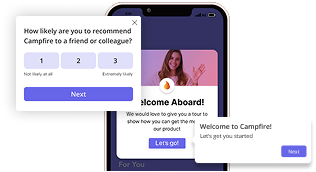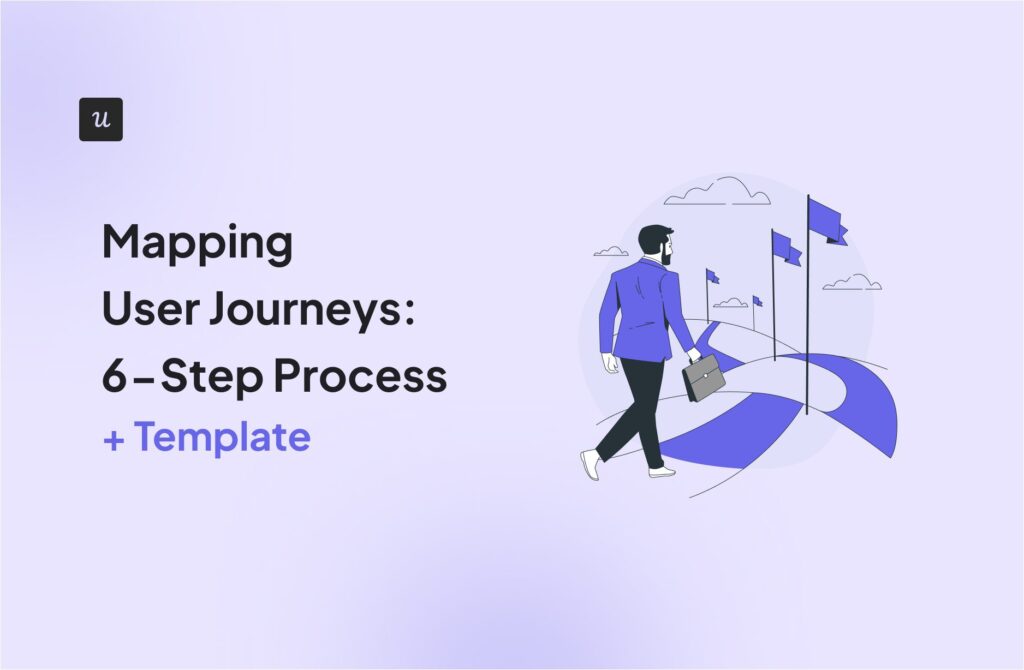
What UX trends are shaping the SaaS industry in 2023?
There’s no denying that UX design plays a significant role in the design of SaaS products. With the rapid growth of technology, each year brings with it new trends.
Let’s go over the ones for 2023 and how they will influence your product.
Try Userpilot Now
See Why 1,000+ Teams Choose Userpilot

What are UX design trends?
A UX design trend is a development or movement in the UX design industry caused by a change in user behavior or the adoption of new technologies.
Why should you care about UX trends?
UX trends are a roadmap to the future of design. It helps a UX designer observe the current state of design and anticipate what’s coming, so you can respond to users’ needs in real-time.
Understanding what users expect when they engage with your product is the first step in improving their experience.
Here’s why UX trends are important:
- It keeps you informed: it gives you a fresh perspective on what’s new in the industry and helps you stay away from outdated UX design.
- Helps you understand the direction of the market: Design trends help you identify changes in your industry and prepare accordingly.
- It prevents you from following trends blindly: It helps UX designers understand the impact of design decisions on their products and users.
- Test things: Design trends help you validate an idea, and reveal if there’s a strong need for it.
What are the current trends in UI/UX design?
To uncover the hottest trends in UI/UX, we asked Linkedin users to vote on the trend with the biggest impact.
To no surprise, personalized user experiences had the highest vote.
So what exactly does “personalized” mean?
It’s all about building products and experiences that cater to a user’s specific needs. This goes beyond addressing a user by name. It involves finding patterns in users’ choices and using them to create deep connections.

Now let’s go over top UX trends you should keep an eye on.
1. Shift towards multiple SSO signup process
To create a frictionless signup flow, SaaS companies are adopting single sign-on (SSO) to provide users with more signup options. With an SSO, a user can log in to multiple apps with one login credential.
Our annual State of SaaS Onboarding report covered how SSO can cut back on signup time and make onboarding better for new users.

Example: How Miro is expanding SSO
Miro is adding more SSO options and removing forms to help users access the product faster. Notice how it’s not just about signing in with Google anymore?
The shift is now towards adding more SSO options that are relevant to your target audience. In this case, Slack or Apple.

2. Hyper-personalization of in-app experiences
People have different wants and needs when they use your product. It’s essential to take these needs into account when designing in-app experiences to retain users in a competitive market.
You can personalize the product experience for users in a number of ways. The key is to trigger relevant experiences for relevant users at the right time.
Here’s how to do that.
Example: Notion’s branched user onboarding flows
During the user onboarding flow, Notion separates users into two segments.
By identifying if a user is part of a team or solo, Notion can make the call about which unnecessary steps a user can skip and how they’d like to navigate the app.
Doing so will tailor each experience to what a specific user segment might need from the product.

Example: Automatic localization of in-app experiences
As companies expand into new markets, there’s a need to localize in-app experiences. In short, product localization customizes a product to accommodate linguistic and cultural differences between users.
Localizing user interfaces is great UX; you can localize apps and web pages by translating content and customizing the UX, including marketing, purchase process, and UI elements.
With a tool like Userpilot, it’s easy to localize in-app experiences like tooltips and modals to appear in a user’s native language.
Here’s an example of how you can translate a tooltip’s content to German.

Enable the button and the microcopy is automatically translated into German. Users who speak German can have a better one-on-one experience this way.

3. More granular user feedback collection
While microsurveys still work great for collecting in-app feedback, we noticed a trend of switching from active to passive customer feedback, which is more contextual and less interrupting.
An active feedback collection is when you trigger surveys and ask for feedback. This could come after the completion of a task or at a touchpoint.
On the other hand, the passive method allows users to provide feedback when they want and provides them with the means to do so without friction.
Provide passive feedback by placing feedback widgets so that they blend into the entire experience, which is better than a survey popping up.
Example: Miro’s microsurveys across the UI
Miro uses microsurveys across micro touchpoints, like after a user creates a new board, to collect passive feedback.
These short customer satisfaction surveys are placed in such a way that they’re easily accessible so users can give feedback on specific experiences.
For example, you can rate your experience on the feed without leaving the screen.

Users can leave feedback based on the emotions they’re feeling when using each feature, by engaging with small feedback widgets.

Example: Userpilot’s passive feedback collection
Userpilot makes this more fun by using different surveys on different screens to collect granular feedback.
Here’s an example of how we gather feedback on our integration screen.
At the bottom right is a simple question, an emoji, and a “suggest an integration” button that’s visible.

Let’s not forget about integrating feedback surveys into your in-app help hub, or as we like to call it, a resource center.
Userpilot uses different feedback surveys, like the ‘submit an idea’ button to suggest new feature ideas and the ‘Give feedback’ button to collect user feedback.

4. Using emotional design across the user experience
Emotive interaction design, or emotional design, is all about creating experiences that evoke an emotional response such as joy or excitement in users.
Positive experiences create memorable interactions and build a deep user connection with a product. This drives them to take action to experience those moments again, and they repeatedly engage with the product.
Here are some examples.
Example: Asana celebrates success and builds connections.
Evoke positive emotions in your UX with gamification elements. Asana does a great job of gamifying its in-app experience.
When you complete a task, Asana celebrates your success by displaying a celebration creature (a unicorn, yeti, narwhal, or phoenix) flying across your screen like a shooting star.
This feature brings a smile to users who look forward to completing more tasks.

They’re also starting to use celebrations as a way to engage team members and make Asana a tool teams enjoy using.

But they don’t stop here.
Even their error messages have a human side and show empathy mixed with a little humor. Instead of getting frustrated, the funny error message ”5 evil cobras jog sadly” makes users smile and makes the interaction memorable.

Example: Userpilot makes the wait enjoyable with inspirational messages
Use inspirational messages to keep users engaged when a page is loading. This not only signals that the app didn’t crash, but also makes the wait more enjoyable.
For example, when Userpilot’s chrome extension builder is loading, we use engaging messages to keep users occupied while everything loads in the background.
User frustration is reduced to a bare minimum.
5. The use of micro-interactions to improve UX
You know when you load a new website and an animated loader comes up? Or when you interact with a button that’s animated?
Those are micro-interactions.
By definition, micro-interactions are small, meaningful, and interactive details that make an experience more intuitive and engaging.
At a glance, these interactions are insignificant when compared to the overall interaction of the app. But interestingly, they create a better customer experience.
Example: Userpilot’s contextual user interface (UI) feedback
Feedback UI is the response generated by the system based on user interactions. It can be as simple as displaying a pop-up for the completion of a task or using a preloader.
An example of this is the loading page of the main app dashboard in Userpilot, which informs users that the system is performing an action.
Progress is displayed through microcopy and graphics to eliminate confusion.

Example: Airtable’s tooltips for guidance
Microcopy is used to describe the tiny bits of text on the UI that help users take action. This includes error messages, placeholder text, and even confirmation messages.
Adding a microcopy—either on a small tooltip, a banner, or a modal—gives users the option to receive answers to their questions in a single sentence.
Here’s an example of how Airtable uses tooltips to display helpful microcopy and get users familiar with their product. When you hover on an element, it explains the feature without interruption.

Example: Loom uses microcopy to set expectations
In Loom, microcopy is used for clarity, to set expectations, and to build trust.
The message on the signup page explains what you’re signing up for and confirms what you’ll be getting after signing up (a Loom business account, which will be downgraded after the trial).

6. The rise of in-app video content
Using videos is another UI/UX design trend expected to dominate soon.
Because videos are more engaging and educate users better, they’re a good replacement for text tutorials, which are boring.
That’s why more SaaS companies are incorporating videos into their product experience to drive product adoption.
Here’s how to incorporate videos into your product.
Example: Tolstoy’s interactive onboarding videos
Tolstoy’s onboarding videos put a spin on how interactive videos can be used to onboard and engage users at the same time.
New users have the freedom to choose their journey type and what they want to see next.

Example: Mixpanel’s micro-videos embedded in UI patterns
Mixpanel embeds micro-videos into new feature announcement modals to give users a quick overview of the new feature.
Micro-videos like this help Mixpanel capture users’ attention, explain their product, and answer questions without frustrating the users.

Example: Userpilot facilitates in-app video tutorial embeds
Add video content to play directly in the resource center. By doing this, users can get help without going to another page, such as YouTube. This is the next level of UX personalization.
These tutorial videos also double as self-service for when users need customer support. Here’s an example in Userpilot.

7. Voice user interface (VUI)
Voice search is another trend making its way into SaaS. We’re already seeing this in action with Amazon, Google, and Apple all integrating voice assistants.
A voice user interface allows users to interact with technology using their voice. It’s a new approach to providing a natural and intuitive user experience.
VUIs are spreading in SaaS; they provide a great alternative to text-based interfaces and serve as a great way to improve customer service.
8. Brand consistency across the journey
Consistency is good UX design; it differentiates an effective product from one with a high churn rate.
Consistent design improves the usability and learnability of a product. Using similar UI elements and functions helps users get to the “Aha Moment” as quickly as possible.
Maintaining consistency cuts across visual elements (e.g., color, font) and functionality on every channel (e.g., websites and mobile apps) and touchpoints.
Even UI patterns like modals, checklists, and tooltips must have a consistent design.
An example is the design of Asana’s in-app communication. Each UI element has the same color, text, and button, so anyone who sees them immediately recognizes them.

While the purple tooltips are used for tips and education, the white ones are for notifications like a task moving to a different project.

9. Virtual reality (VR)
Although virtual reality (VR) is a new frontier in UX design, it’s rapidly evolving.
Virtual reality is a simulated environment in which designers can mimic real-life experiences. The move into the world of 3D will completely change the way users interact with products.
In 2023, it’s likely we’ll see more VR experiences combined with UX design, like interacting with 3D spaces on UI interfaces.
The good thing is that VR helps your customers connect with your brand, which in turn boosts your user retention rate.
10. Uninterrupted UX and decluttered UI’s
In-app prompts are great for driving user engagement, but only if designers are mindful of the UX.
Being mindful means maintaining an awareness of a user’s thoughts, feelings, and sensations when using a product. For instance, take note of the widgets that are triggered when users interact with features.
Choose between small native tooltips vs. modals vs. popups to enhance the user’s learning. Banners can replace big modals for NPS or announcements.
Also, playing help videos in-app declutters the UI from multiple popups at the same time, etc.
Example: Figma’s banners that blend in with your UI
Figma designs their upgrade messages, banners, and native tooltips all on one screen so they look like they belong there.
Designing these in-app prompts as pop-ups could distract the users. But this design approach used by Figma makes it easier to convert users without irritating them.

Example: Storychief’s placeholder text
Storychief uses placeholder text to guide users with short hints on the expected value of an input field. For instance, when you launch a blank screen, the placeholder text gives you a short description of what to write in the input field.

Conclusion
Now that we’ve seen the UX trends in 2023, it’s time to take action. Start by creating a personalized user experience without coding. Book a Demo with our team and get started today!






